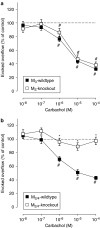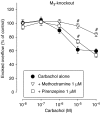Distinct mixtures of muscarinic receptor subtypes mediate inhibition of noradrenaline release in different mouse peripheral tissues, as studied with receptor knockout mice
- PMID: 15965496
- PMCID: PMC1576238
- DOI: 10.1038/sj.bjp.0706297
Distinct mixtures of muscarinic receptor subtypes mediate inhibition of noradrenaline release in different mouse peripheral tissues, as studied with receptor knockout mice
Abstract
The muscarinic heteroreceptors modulating noradrenaline release in atria, urinary bladder and vas deferens were previously studied in mice in which the M(2) or the M(4) muscarinic receptor genes had been disrupted. These experiments showed that these tissues possessed both M(2) and non-M(2) heteroreceptors. The analysis was now extended to mice in which either the M(3), both the M(2) and the M(3), or both the M(2) and the M(4) genes had been disrupted (M(3)-knockout, M(2/3)-knockout and M(2/4)-knockout). Tissues were preincubated with (3)H-noradrenaline and then stimulated electrically (20 pulses per 50 Hz). In wild-type atria, carbachol (0.01-100 microM) decreased the electrically evoked tritium overflow by maximally 60-78%. The maximum inhibition of carbachol was reduced to 57% in M(3)-knockout and to 23% in M(2/4)-knockout atria. Strikingly, the effect of carbachol was abolished in M(2/3)-knockout atria. In wild-type bladder, carbachol (0.01-100 microM) reduced the evoked tritium overflow by maximally 57-71%. This effect remained unchanged in the M(3)-knockout, but was abolished in the M(2/4)-knockout bladder. In wild-type vas deferens, carbachol (0.01-100 microM) reduced the evoked tritium overflow by maximally 34-48%. The maximum inhibition of carbachol was reduced to 40% in the M(3)-knockout and to 18% in the M(2/4)-knockout vas deferens. We conclude that the postganglionic sympathetic axons of mouse atria possess M(2) and M(3), those of the urinary bladder M(2) and M(4), and those of the vas deferens M(2), M(3) and M(4) release-inhibiting muscarinic receptors.
Figures




Similar articles
-
Heterogeneity of presynaptic muscarinic receptors mediating inhibition of sympathetic transmitter release: a study with M2- and M4-receptor-deficient mice.Br J Pharmacol. 2003 Feb;138(3):469-80. doi: 10.1038/sj.bjp.0705053. Br J Pharmacol. 2003. PMID: 12569072 Free PMC article.
-
Heterogeneity of release-inhibiting muscarinic autoreceptors in heart atria and urinary bladder: a study with M(2)- and M(4)-receptor-deficient mice.Naunyn Schmiedebergs Arch Pharmacol. 2002 Feb;365(2):112-22. doi: 10.1007/s00210-001-0517-7. Epub 2001 Dec 18. Naunyn Schmiedebergs Arch Pharmacol. 2002. PMID: 11819029
-
3H-Noradrenaline release from mouse iris-ciliary body: role of presynaptic muscarinic heteroreceptors.Naunyn Schmiedebergs Arch Pharmacol. 2004 Oct;370(4):305-13. doi: 10.1007/s00210-004-0972-z. Epub 2004 Sep 16. Naunyn Schmiedebergs Arch Pharmacol. 2004. PMID: 15375642
-
Muscarinic receptors in the bladder: from basic research to therapeutics.Br J Pharmacol. 2006 Feb;147 Suppl 2(Suppl 2):S80-7. doi: 10.1038/sj.bjp.0706560. Br J Pharmacol. 2006. PMID: 16465186 Free PMC article. Review.
-
Energy requirements for the basal efflux of noradrenaline and its metabolites from adrenergic varicosities.J Neural Transm Suppl. 1991;34:19-25. doi: 10.1007/978-3-7091-9175-0_3. J Neural Transm Suppl. 1991. PMID: 1817160 Review.
Cited by
-
The detection of the non-M2 muscarinic receptor subtype in the rat heart atria and ventricles.Naunyn Schmiedebergs Arch Pharmacol. 2008 Jul;378(1):103-16. doi: 10.1007/s00210-008-0285-8. Epub 2008 Apr 29. Naunyn Schmiedebergs Arch Pharmacol. 2008. PMID: 18443764
-
Decrease in heart adrenoceptor gene expression and receptor number as compensatory tool for preserved heart function and biological rhythm in M(2) KO animals.Naunyn Schmiedebergs Arch Pharmacol. 2012 Dec;385(12):1161-73. doi: 10.1007/s00210-012-0800-9. Epub 2012 Oct 24. Naunyn Schmiedebergs Arch Pharmacol. 2012. PMID: 23093370
-
Es kann die Spur von unseren Erdetagen--on pharmacologists and pharmacology.Naunyn Schmiedebergs Arch Pharmacol. 2009 Nov;380(5):465-71. doi: 10.1007/s00210-009-0443-7. Naunyn Schmiedebergs Arch Pharmacol. 2009. PMID: 19760274
-
Synthesis, trafficking, and localization of muscarinic acetylcholine receptors.Pharmacol Ther. 2008 Jul;119(1):33-43. doi: 10.1016/j.pharmthera.2008.04.006. Epub 2008 May 16. Pharmacol Ther. 2008. PMID: 18558434 Free PMC article. Review.
-
The pharmacological rationale for combining muscarinic receptor antagonists and β-adrenoceptor agonists in the treatment of airway and bladder disease.Curr Opin Pharmacol. 2014 Jun;16(100):31-42. doi: 10.1016/j.coph.2014.03.003. Epub 2014 Mar 27. Curr Opin Pharmacol. 2014. PMID: 24682092 Free PMC article. Review.
References
-
- ALTMAN J.D., TRENDELENBURG A.U., MACMILLAN L., BERNSTEIN D., LIMBIRD L., STARKE K., KOBILKA B.K., HEIN L. Abnormal regulation of the sympathetic nervous system in α2A-adrenergic receptor knockout mice. Mol. Pharmacol. 1999;56:154–161. - PubMed
-
- BÜCHELER M.M., HADAMEK K., HEIN L. Two α2-adrenergic receptor subtypes, α2A and α2C, inhibit transmitter release in the brain of gene-targeted mice. Neuroscience. 2002;109:819–826. - PubMed
-
- CAULFIELD M.P., BIRDSALL N.J. International Union of Pharmacology. XVII. Classification of muscarinic acetylcholine receptors. Pharmacol. Rev. 1998;50:279–290. - PubMed
-
- DOERJE F., LEVEY A.I., BRANN M.R. Immunological detection of muscarinic receptor subtype proteins (m1–m5) in rabbit peripheral tissues. Mol. Pharmacol. 1991;40:459–462. - PubMed
Publication types
MeSH terms
Substances
LinkOut - more resources
Full Text Sources
Molecular Biology Databases

